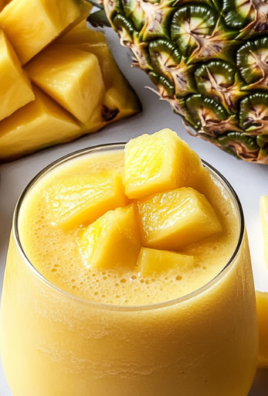
Mango lassi is a beloved Indian beverage known for its creamy texture, refreshing taste, and perfect balance of sweetness and tanginess. A blend of ripe mangoes, yogurt, and spices, it has gained global recognition, often featured on restaurant menus worldwide. Whether enjoyed as a cooling summer drink or a complement to spicy dishes, mango lassi remains a staple in Indian cuisine.
The combination of mango and yogurt in this drink makes it not only delicious but also highly nutritious. Mangoes are packed with vitamins A and C, while yogurt provides probiotics beneficial for gut health. The versatility of this drink allows for customization with different flavors, sweeteners, and toppings.
Historical Background and Cultural Significance
Origins of Lassi
Lassi, a traditional Indian yogurt-based drink, has been a part of Indian culinary culture for centuries. It traces its roots to ancient Ayurvedic practices, where fermented dairy products were highly valued for their cooling and digestive properties. The original form of lassi consisted of churned yogurt mixed with water, sometimes flavored with salt or spices.
Evolution of Mango Lassi
As mangoes became an integral part of Indian agriculture, it was only natural for this fruit to be incorporated into lassi. This variation gained popularity, especially in regions where mangoes were abundant, such as Punjab and Maharashtra. Over time, mango lassi became a symbol of indulgence, enjoyed during summer months and festive occasions.
Cultural Importance
Mango lassi is often associated with hospitality in India. It is commonly offered to guests as a sign of warmth and welcome. In festivals like Holi and Diwali, mango lassi serves as a refreshing treat, balancing the rich and spicy flavors of traditional Indian dishes. Additionally, it is a popular offering in temples, symbolizing purity and nourishment.
Preparation Phase & Tools to Use
Essential Tools and Equipment
To make the perfect mango lassi, having the right tools is crucial:
- Blender: Ensures a smooth and creamy texture.
- Measuring Cups and Spoons: Helps maintain the correct proportions.
- Knife and Cutting Board: For peeling and chopping mangoes.
- Serving Glasses: Traditional clay cups (kulhars) or regular glasses enhance presentation.
- Mixing Spoon: To blend ingredients evenly before serving.
Importance of Each Tool
Each tool plays a role in creating a well-balanced lassi. A powerful blender is necessary for achieving a smooth consistency, while measuring tools help avoid an overpowering taste from excessive sweeteners or spices. Serving in traditional kulhars adds authenticity and enhances the drinking experience.
Preparation Tips
- Choose Ripe Mangoes: Alphonso, Kesar, or Ataulfo mangoes provide natural sweetness and vibrant color.
- Chill Ingredients: Using cold yogurt and milk results in a more refreshing drink.
- Balance Consistency: Adjust the thickness by adding milk or water.
- Avoid Over-blending: Over-blending can make the lassi too frothy.
Ingredients List
Core Ingredients
- Ripe mangoes – 2 medium-sized or 1 cup of mango pulp.
- Plain yogurt – 1 cup (Greek yogurt for a thicker consistency).
- Milk or water – ½ cup (adjust for desired thickness).
- Sweetener (optional) – 2 tbsp sugar or honey.
- Ice cubes – 4-5 cubes for a chilled lassi.
Flavor Enhancements
- Cardamom powder – ¼ tsp for an aromatic touch.
- Rose water – 1 tsp for floral essence.
- Saffron strands – A pinch, soaked in warm milk for richness.
Optional Garnishes
- Chopped nuts (pistachios, almonds)
- Mint leaves
- Saffron strands
Step-by-Step Instructions
Preparation Time
- 10 minutes
Cook Time
- Not applicable
Total Time
- 10 minutes
Servings
- 2 servings
Yield
- 2 cups of mango lassi
Step-by-Step Process
- Prepare the Mangoes:
- Peel and chop ripe mangoes into small pieces.
- If using canned mango pulp, measure out 1 cup.
- Blend the Ingredients:
- In a blender, combine mango pieces, yogurt, milk (or water), and sweetener.
- Add cardamom powder and rose water for additional flavor.
- Blend Until Smooth:
- Process until the mixture is creamy and lump-free.
- Adjust consistency by adding more milk if needed.
- Taste and Adjust:
- Check for sweetness and balance flavors accordingly.
- Serve:
- Pour into serving glasses.
- Garnish with chopped nuts or saffron.
- Chill and Enjoy:
- Serve immediately or refrigerate for 15 minutes for enhanced flavor.
By following these steps, you can create a restaurant-style mango lassi at home, rich in taste and texture.
Enhancements and Nutritional Insights
Side Dish Recommendations
Mango lassi pairs wonderfully with a variety of Indian snacks and meals. The creamy, sweet, and tangy flavors complement spicy, savory, and crunchy dishes. Here are some popular side dishes that go well with mango lassi.
1. Samosas
Samosas are crispy, deep-fried pastries stuffed with a spiced potato filling. The contrast between the spicy filling and the cooling mango lassi creates a perfect balance.
2. Pakoras
Pakoras are deep-fried fritters made with gram flour and vegetables such as potatoes, onions, or spinach. The slight tanginess of mango lassi complements the crispy texture of pakoras.
3. Aloo Tikki
Aloo tikki, or spiced potato patties, are crunchy on the outside and soft on the inside. They are often served with chutneys, but mango lassi adds a refreshing twist to the meal.
4. Paneer Tikka
Marinated and grilled paneer cubes, known as paneer tikka, have a smoky and slightly spicy taste. Mango lassi helps to neutralize the heat, making the combination enjoyable.
5. Chole Bhature
This rich and hearty dish consists of spicy chickpea curry (chole) and deep-fried bread (bhature). Mango lassi provides a cooling effect, making it an excellent pairing for this heavy meal.
6. Dhokla
Dhokla is a steamed, savory snack made from fermented gram flour. Its spongy texture and slightly sour taste contrast well with the smooth and sweet mango lassi.
7. Pani Puri
Pani puri, also known as golgappa, is a popular street food made of crispy shells filled with tangy tamarind water and spicy potatoes. Mango lassi helps balance the intense flavors of this dish.
8. Bhel Puri
Bhel puri is a crunchy and tangy snack made from puffed rice, sev, and chutneys. The sweetness of mango lassi complements the spiciness and acidity of this street food favorite.
Nutritional Information & Health Benefits
Nutritional Breakdown
Mango lassi is packed with essential nutrients from both mangoes and yogurt. It is rich in vitamins, minerals, and probiotics.
- Calories – Moderate, depending on the use of sugar or honey.
- Carbohydrates – Primarily from mangoes and added sweeteners.
- Proteins – Provided by yogurt, supporting muscle health.
- Fats – Minimal, unless full-fat yogurt is used.
- Fiber – Present in mangoes, aiding digestion.
- Vitamins and Minerals – High in vitamin C, vitamin A, calcium, and potassium.
Health Benefits
- Probiotic Powerhouse: The yogurt in mango lassi contains beneficial bacteria that improve gut health and digestion.
- Boosts Immunity: Mangoes are rich in vitamin C and antioxidants, which help strengthen the immune system.
- Hydration and Cooling Effect: This drink helps keep the body hydrated, making it ideal for hot weather.
- Supports Bone Health: The calcium and vitamin D in yogurt contribute to stronger bones.
- Aids Digestion: The combination of mango and yogurt soothes the digestive system and helps with nutrient absorption.
Common Mistakes to Avoid & How to Perfect the Recipe
Common Mistakes
- Using Unripe Mangoes: Unripe mangoes can make the lassi too sour or fibrous. Always choose fully ripe mangoes for the best sweetness and texture.
- Adding Too Much Sweetener: Over-sweetening can overpower the natural mango flavor. Start with a small amount of sugar or honey and adjust to taste.
- Incorrect Yogurt Choice: Using overly tangy yogurt can make the lassi too sour. Opt for fresh, mild-flavored yogurt.
- Improper Blending: Over-blending can create excess froth, while under-blending may leave lumps. Blend until just smooth.
- Wrong Consistency: Too thick lassi can be difficult to drink, while too thin loses its creamy texture. Adjust by adding milk or water gradually.
- Skipping Chilling: Serving mango lassi warm diminishes its refreshing quality. Use chilled ingredients or refrigerate before serving.
By avoiding these mistakes, you can ensure a perfect mango lassi every time.




Leave a Comment